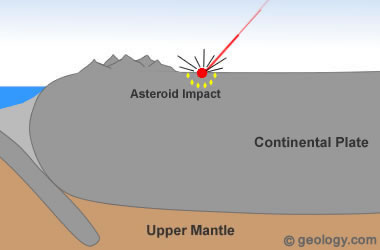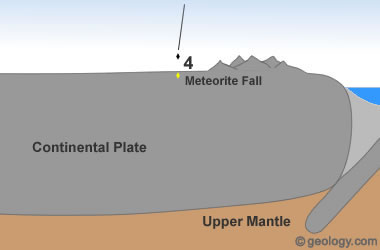Contrary to what many people believe, most diamonds do not form from coal. 
Diamonds
found at or near Earth's surface have formed through four different
processes. The plate tectonics cartoon above presents these four
methods of diamond formation. Additional information about each of them
can be found in the paragraphs and small cartoons below.
Methods of Diamond Formation Many people believe that diamonds are formed from the metamorphism of
coal. That idea continues to be the "how diamonds form" story in many
science classrooms.
Coal has rarely played a role in the formation of diamonds. In fact,
most diamonds that have been dated are much older than Earth's first
land plants - the source material of coal! That alone should be enough
evidence to shut down the idea that Earth's diamond deposits were
formed from coal.
Another problem with the idea is that coal seams are sedimentary rocks
that usually occur as horizontal or nearly horizontal rock units.
However, the source rocks of diamonds are vertical pipes filled with
igneous rocks.
Four processes are thought to be responsible for virtually all of the
natural diamonds that have been found at or near Earth's surface. One of
these processes accounts for nearly 100% of all diamonds that have ever
been mined. The remaining three are insignificant sources of
commercial diamonds.
These processes rarely involve coal.
1) Diamond Formation in Earth's MantleGeologists believe that the diamonds in all of Earth's commercial
diamond deposits were formed in the mantle and delivered to the surface
by deep-source volcanic eruptions.
These eruptions produce the kimberlite and lamproite pipes that are
sought after by diamond prospectors. Diamonds weathered and eroded from
these eruptive deposits are now contained in the sedimentary (placer)
deposits of streams and coastlines.
The formation of natural diamonds requires very high temperatures and
pressures. These conditions occur in limited zones of Earth's mantle
about 90 miles (150 kilometers) below the surface where temperatures are
at least 2000 degrees Fahrenheit (1050 degrees Celsius) (1).
This critical temperature-pressure environment for diamond formation and
stability is not present globally. Instead it is thought to be present
primarily in the mantle beneath the stable
interiors of continental plates (2).
Diamonds formed and stored in these "diamond stability zones" are
delivered to Earth's surface during deep-source volcanic eruptions.
These eruptions tear out pieces of the mantle and carry them rapidly to
the surface (3), See Location 1 in the diagrams above and at right.
This type of volcanic eruption is extremely rare and has not occurred
since scientists have been able to recognize them.
Is coal involved? Coal is a sedimentary rock, formed from plant debris
deposited at Earth's surface. It is rarely buried to depths greater
than two miles (3.2 kilometers). It is very unlikely that coal has been
moved from the crust down to a depth well below the base of a
continental plate.
The carbon source for these mantle diamonds is most likely carbon
trapped in Earth's interior at the time of the planet's formation.
2) Diamond Formation in Subduction Zones Tiny diamonds have been found in rocks that are thought to have been
subducted deep into the mantle by plate tectonic processes - then
returned to the surface (4), See Location 2 in the diagrams above and at
right.
Diamond formation in a subducting plate might occur as little as 50
miles (80 kilometers) below the surface and at temperatures as low as
390 degrees Fahrenheit (200 degrees Centigrade) (1).
Is coal involved? Coal is a possible carbon source for this
diamond-forming process. However, oceanic plates are more likely
candidates for subduction than continental plates because of their
higher density. The most likely carbon sources from the subduction of an
oceanic plate are carbonate rocks such as limestone,
marble and dolomite and possibly particles of plant debris in offshore
sediments.
2) Diamond Formation in Subduction Zones Tiny diamonds have been found in rocks that are thought to have been
subducted deep into the mantle by plate tectonic processes - then
returned to the surface (4), See Location 2 in the diagrams above and at
right.
Diamond formation in a subducting plate might occur as little as 50
miles (80 kilometers) below the surface and at temperatures as low as
390 degrees Fahrenheit (200 degrees Centigrade) (1).
Is coal involved? Coal is a possible carbon source for this
diamond-forming process. However, oceanic plates are more likely
candidates for subduction than continental plates because of their
higher density. The most likely carbon sources from the subduction of an
oceanic plate are carbonate rocks such as limestone,
marble and dolomite and possibly particles of plant debris in offshore
sediments.
3) Diamond Formation at Impact SitesThroughout its history, Earth has been repeatedly hit by large
asteroids. When these asteroids strike the earth extreme temperatures
and pressures are produced. For example: when a six mile (10 kilometer)
wide asteroid strikes the earth, it can be traveling at up to 9 to 12
miles per second (15 to 20 kilometers per second). Upon impact this
hypervelocity object would produce an energy burst equivalent to
millions of nuclear weapons and temperatures hotter than the sun's
surface (5).
The high temperature and pressure conditions of such an impact are more
than adequate to form diamonds.
This theory of diamond formation has been supported by the discovery of
tiny diamonds around several asteroid impact sites. See Location 3 in
the diagrams above and at right.
Is coal involved? Coal could be present in the target area of these
impacts and could serve as the carbon source of the diamonds.
Limestones, marbles, dolomites and other carbon-bearing rocks are also
potential carbon sources.
4) Formation in Space NASA researchers have detected large numbers of nanodiamonds in some
meteorites (nanodiamonds are diamonds that are a few nanometers -
billionths of a meter in diameter). About three percent of the carbon
in these meteorites is contained in the form of nanodiamonds. These
diamonds are too small for use as gems or industrial abrasives, however,
they are a source of diamond material (6), See Location 4 in the
diagrams above and at right.
Smithsonian researchers also found large numbers of tiny diamonds when
they were cutting a sample from the Allen Hills meteorite (7). These
diamonds in meteorites are thought to have formed in space through high
speed collisions similar to how diamonds form on Earth at impact sites.
Is coal involved? Coal is not involved in the creation of these diamonds.
The carbon source is from a body other than Earth.
The Most Convincing Evidence The most convincing evidence that coal did not play a role in the
formation of most diamonds is a comparison between the age of Earth's
diamonds and the age of the earliest land plants.
Almost every diamond that has been dated formed during the Precambrian Eon - the span of time between
Earth's formation (about 4,600 million years ago) and the start of the Cambrian Period (about 542 million years ago).
In contrast, the earliest land plants did not appear on Earth until about 450 million years ago - nearly 100 million
years after the formation of virtually all of Earth's natural diamonds.
Since coal is formed from terrestrial plant debris and the oldest land plants are younger than almost every
diamond that has ever been dated, it is easy to conclude that coal did not play a significant role
in the formation of Earth's diamonds.
| 2) Subduction Zone Diamonds |

Subduction
zones occur at convergent plate boundaries where one plate is forced
down into the mantle. As this plate descends it is exposed to increasing
temperature and pressure. Diamonds have been found in rocks that are
thought to have been subducted and then returned to the surface. These
types of rocks are very rare and no known commercial diamond deposits
have been developed within them. The diamonds found in these types of
deposits have been very small and not suitable for commercial use. |
| 3) Asteroid Impact Diamonds |

Diamonds
have been found in and around the craters of asteroid impact sites.
Earth has been repeatedly hit by asteroids throughout its history. These
asteroids hit with such force that pressures and temperatures high
enough to form diamonds are produced. If the target rock contains carbon
the conditions needed to form diamonds might occur within the impact
area. These types of diamonds are rare and do not play an important role
in commercial diamond mining. |
| 4) Diamonds Formed in Space |

Diamonds
have been discovered in some meteorites. These diamonds are thought to
have formed in space in response to asteroid impacts or other severe
events.
